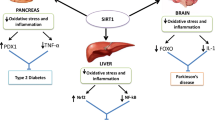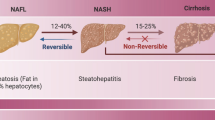Abstract
Activated hepatic stellate cells (HSCs) are considered the major drivers in the process of hepatic fibrosis. This study intends to explore the mechanism underlying microRNA (miR)-34b-5p effects over liver fibrosis through the enhancer of zeste 2 (EZH2)/milk fat globule-EGF factor 8 (MFGE8) axis in HSCs. A liver fibrosis model was generated by carbon tetrachloride (CCl4) in C57BL/6 J mice and subjected to histological examinations and detection of HSC activation and miR-34b-5p/EZH2/MFGE8 expression. Primary HSCs were treated with transforming growth factor (TGF)-β and tested for proliferation, activation, and expression of fibrosis-related factors. A dual luciferase reporter assay was performed for confirming the targeted relationship between miR-34b-5p and EZH2. Chromatin immunoprecipitation was used to measure EZH2 enrichment in the MFGE8 promoter region. We found that miR-34b-5p was lowly expressed in the CCl4-induced mouse model. Overexpression of miR-34b-5p suppressed both TGF-β-induced HSC proliferation and the expression of fibrosis-related factors and HSC activation markers. A dual luciferase assay showed a binding relationship between miR-34b-5p and EZH2. Overexpression of miR-34b-5p reduced TGF-β-induced HSC activation by inhibiting EZH2 to promote MFGE8 expression. Overexpression of miR-34b-5p inhibited liver fibrosis in vivo through the EZH2/MFGE8 axis. Conclusively, overexpressing miR-34b-5p reduced TGF-β-induced HSC activation by inhibiting EZH2 and thereby promoting MFGE8 expression, and inhibited liver fibrosis in vivo through the EZH2/MFGE8 axis.





Similar content being viewed by others
Data availability
The datasets used or analyzed during the current study are available from the corresponding author on reasonable request.
References
Aydin MM, Akcali KC (2018) Liver fibrosis. Turk J Gastroenterol 29:14–21
Schuppan D (2015) Liver fibrosis: common mechanisms and antifibrotic therapies. Clin Res Hepatol Gastroenterol 39(Suppl 1):S51-59
Higashi T, Friedman SL, Hoshida Y (2017) Hepatic stellate cells as key target in liver fibrosis. Adv Drug Deliv Rev 121:27–42
Roehlen N, Crouchet E, Baumert TF (2020) Liver fibrosis: mechanistic concepts and therapeutic perspectives. Cells 9: 875
Campana L, Iredale JP (2017) Regression of liver fibrosis. Semin Liver Dis 37:1–10
Altamirano-Barrera A, Barranco-Fragoso B, Mendez-Sanchez N (2017) Management strategies for liver fibrosis. Ann Hepatol 16:48–56
Hyun J, Wang S, Kim J et al (2016) MicroRNA-378 limits activation of hepatic stellate cells and liver fibrosis by suppressing Gli3 expression. Nat Commun 7:10993
Matsumoto Y, Itami S, Kuroda M et al (2016) MiR-29a assists in preventing the activation of human stellate cells and promotes recovery from liver fibrosis in mice. Mol Ther 24:1848–1859
Zhou L, Liu S, Han M et al (2018) miR-185 inhibits fibrogenic activation of hepatic stellate cells and prevents liver fibrosis. Mol Ther Nucleic Acids 10:91–102
Li WQ, Chen C, Xu MD et al (2011) The rno-miR-34 family is upregulated and targets ACSL1 in dimethylnitrosamine-induced hepatic fibrosis in rats. FEBS J 278:1522–1532
Feili X, Wu S, Ye W, Tu J, Lou L (2018) MicroRNA-34a-5p inhibits liver fibrosis by regulating TGF-beta1/Smad3 pathway in hepatic stellate cells. Cell Biol Int 42:1370–1376
Hu RP, Lu YY, Zhang XJ (2019) MiR-34b-5p knockdown attenuates bleomycin-induced pulmonary fibrosis by targeting tissue inhibitor of metalloproteinase 3 (TIMP3). Eur Rev Med Pharmacol Sci 23:2273–2279
Aghdam AM, Amiri A, Salarinia R et al (2019) MicroRNAs as diagnostic, prognostic, and therapeutic biomarkers in prostate cancer. Crit Rev Eukaryot Gene Expr 29:127–139
Jiang Y, Xiang C, Zhong F et al (2021) Histone H3K27 methyltransferase EZH2 and demethylase JMJD3 regulate hepatic stellate cells activation and liver fibrosis. Theranostics 11:361–378
Mann J, Chu DC, Maxwell A et al (2010) MeCP2 controls an epigenetic pathway that promotes myofibroblast transdifferentiation and fibrosis. Gastroenterology 138:705-14, 714.e1-4
An SY, Jang YJ, Lim HJ et al (2017) Milk fat globule -EGF factor 8, Secreted by mesenchymal stem cells, protects against liver fibrosis in mice. Gastroenterology 152:1174–1186
Jang YJ, An SY, Kim JH (2017) Identification of MFGE8 in mesenchymal stem cell secretome as an anti-fibrotic factor in liver fibrosis. BMB Rep 50:58–59
Li H, Zhang T, Wang K et al (2019) MFGE8 protects against CCl4 -induced liver injury by reducing apoptosis and promoting proliferation of hepatocytes. J Cell Physiol: Online ahead of print
Jinushi T, Shibayama Y, Kinoshita I et al (2014) Low expression levels of microRNA-124-5p correlated with poor prognosis in colorectal cancer via targeting of SMC4. Cancer Med 3:1544–1552
Du Z, Wu T, Liu L, Luo B, Wei C (2021) Extracellular vesicles-derived miR-150-5p secreted by adipose-derived mesenchymal stem cells inhibits CXCL1 expression to attenuate hepatic fibrosis. J Cell Mol Med 25:701–715
Li L, Sun Z, Xu C et al (2018) Adenovirus-mediated overexpression of sST2 attenuates cardiac injury in the rat with severe acute pancreatitis. Life Sci 202:167–174
Wu J, Wang J, Li X et al (2017) MicroRNA-145 mediates the formation of angiotensin II-induced murine abdominal aortic aneurysm. Heart Lung Circ 26:619–626
Ishak K, Baptista A, Bianchi L et al (1995) Histological grading and staging of chronic hepatitis. J Hepatol 22:696–699
Lim JY, Oh MA, Kim WH, Sohn HY, Park SI (2012) AMP-activated protein kinase inhibits TGF-beta-induced fibrogenic responses of hepatic stellate cells by targeting transcriptional coactivator p300. J Cell Physiol 227:1081–1089
Roderburg C, Urban GW, Bettermann K et al (2011) Micro-RNA profiling reveals a role for miR-29 in human and murine liver fibrosis. Hepatology 53:209–218
Venugopal SK, Jiang J, Kim TH et al (2010) Liver fibrosis causes downregulation of miRNA-150 and miRNA-194 in hepatic stellate cells, and their overexpression causes decreased stellate cell activation. Am J Physiol Gastrointest Liver Physiol 298:G101-106
Dewidar B, Meyer C, Dooley S, Meindl-Beinker AN (2019) TGF-beta in hepatic stellate cell activation and liver fibrogenesis-updated 2019. Cells 8:1419
Lee S, Woo DC, Kang J et al (2020) The role of the histone methyltransferase EZH2 in liver inflammation and fibrosis in STAM NASH mice. Biology (Basel) 9:93
Lu Y, Liu L, Pan J et al (2021) MFG-E8 regulated by miR-99b-5p protects against osteoarthritis by targeting chondrocyte senescence and macrophage reprogramming via the NF-kappaB pathway. Cell Death Dis 12:533
Acknowledgements
We acknowledge and appreciate our colleagues for their valuable efforts and comments on this paper.
Funding
The grants were provided from the National Natural Science Foundation of Hunan Province (No.2022JJ30825), the National Natural Science Foundation of China (Nos. 81974079, 81500455, 32100597, 82070646), the National Key R&D Program of China (No. 2019YFE0190800) and the Key R&D Program of Hunan Province (No. 2020SK2083).
Author information
Authors and Affiliations
Contributions
The authors declare that all the data were generated in-house and that no paper mill was used. MJ and JYF conceived the ideas. MJ and JYF designed the experiments. MJ, LQY, and CMX performed the experiments. MJ, JYF, HB, and LY analyzed the data. MJ, JYF, and ZM provided the critical materials. LQY and CMX wrote the manuscript. MJ and JYF supervised the study. All the authors have read and approved the final version for publication.
Corresponding author
Ethics declarations
Ethics approval and consent to participate
The animals were housed per the protocols permitted by the Institutional Animal Care and Use Committee of The Second Xiangya Hospital. All the experimental protocols obtained permission from the Animal Use Ethics Committee of The Second Xiangya Hospital (No. 2021524).
Consent for publication
All the authors agreed with the content and all gave explicit consent to submit and that they obtained consent from the responsible authorities at the institute/organization where they work, before the work is submitted.
Conflict of interest
The authors declare no competing interests.
Additional information
Publisher's note
Springer Nature remains neutral with regard to jurisdictional claims in published maps and institutional affiliations.
Key points
• MiR-34b-5p is lowly expressed and EZH2 is highly expressed in liver fibrosis.
• Overexpression of miR-34b-5p inhibits hepatic stellate cell activation.
• MiR-34b-5p represses EZH2 expression.
• EZH2 represses MEGF8 expression through histone methylation.
• MiR-34b-5p/EZH2/MEGF8 affects hepatic stellate cell activation and liver fibrosis.
Rights and permissions
Springer Nature or its licensor holds exclusive rights to this article under a publishing agreement with the author(s) or other rightsholder(s); author self-archiving of the accepted manuscript version of this article is solely governed by the terms of such publishing agreement and applicable law.
About this article
Cite this article
Ma, J., Liu, Q., Chen, M. et al. MicroRNA-34b-5p binds enhancer of zeste 2 to inhibit milk fat globule-EGF factor 8 expression, affecting liver fibrosis. J Physiol Biochem 78, 885–895 (2022). https://doi.org/10.1007/s13105-022-00914-4
Received:
Accepted:
Published:
Issue Date:
DOI: https://doi.org/10.1007/s13105-022-00914-4




